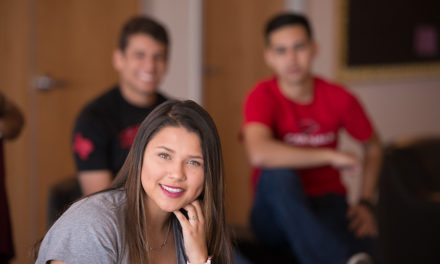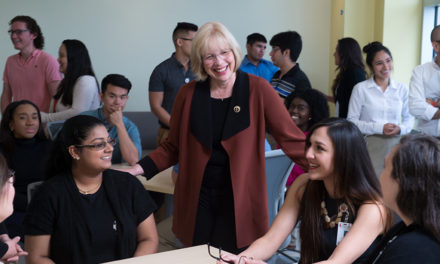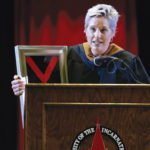Edited by Ashley Festa

UIW faculty members from India are Dr. Sushma Ramsinghani (from left), Dr. Neeta Singh, Dr. Lopita Nath, Dr. Alakananda “Alaka” Chaudhuri and Dr. Sheeba Varghese Gupta.
The University of the Incarnate Word welcomes to its community diverse populations from throughout the world. This is not only evident in the diversity of the student body, but also in the rich tapestry of faculty and staff who work here. I’d like to introduce to you five faculty members from India: Dr. Sheeba Varghese Gupta, assistant professor in the Feik School of Pharmacy; Dr. Lopita Nath, assistant professor of history; Dr. Sushma Ramsinghani; interim assistant dean in the pharmacy school; Dr. Neeta Singh, associate professor of nutrition; and Dr. Alakananda “Alaka” Chaudhuri, associate professor of chemistry. “They are really a microcosm of the enormous diversity within the large country of India and a visible symbol of the diversity that has grown within the University of the Incarnate Word,” said Dr. Denise Doyle, provost. I had the privilege to sit down with these professors to get their thoughts on diversity, religion, culture, teaching, food, fears, and a number of other topics. Here’s what they had to say:
Ashley Festa: You are all from one country, but it’s very diverse like the United States. How are things different within India?
Sushma Ramsinghani: Part of the uniqueness of India is that we have so many languages. Everyone speaks a different mother tongue. Yet we all are bound by one national language, which is Hindi, so we can understand everyone through that language.
Alaka Chaudhuri: It’s diverse in every respect, such as traditional clothes, food, culture. There’s a lot of cultural diversity.
Sheeba Varghese Gupta: I can give you an example of cultural diversity in my family. I’m from South India. I’m married to a North Indian, who’s a Hindu, and I’m a Catholic. Our families speak two different languages, but they still manage to communicate with each other. Even though we are so different in so many aspects, we exist in a very happy environment.
Lopita Nath: Within my family, there’s a very good mix of religion and cultures and everything. It’s to the point you don’t even realize it; you don’t have a different identity, it’s so mixed up. I think that is the true Indianness that everybody represents.
Alaka Chaudhuri: There is something that is common, that isn’t very obvious all the time. It’s not that it’s all different, but that there is a uniqueness that everything is united. Mostly the common language is English because not everyone speaks Hindi fluently.
Lopita Nath: There is no one India; there are multiple Indias. And that is the uniqueness of the whole country. There are so many Indias that everybody will give you a different picture of the country. We have 22 or 23 modern Indian languages according to the state, but almost 55,000 dialects.
AC: And food is so different. It’s cooked in a totally different way. Food here (in the U.S.) is more close to North Indian. Like one part of India would not eat meat or fish, and another part are all meat-eaters.
Neeta Singh: When I think of the places we are all from, I see it as a modern India. The definitions are blurred. It’s a very organized mix, and we somehow try to maintain our identity.
SR: There are more weddings and marriages between cultures, so that’s getting more blurred. Probably in a generation or two, it will be more like one India.
NS: And I think it’s in a good sense.
SR: Yes, I like the mixed families.
LN: The diversity is becoming more like a multiculturalism in a very positive way.
AF: What made you want to come to UIW?
SR: I was a faculty member at Hampton University, and then I came to UIW. I wanted to be in an environment where I can teach and do research. Both of them are equally important to me, so I wanted to be at a place that allowed me to do both. At some of the big universities, you’re under tremendous pressure to bring in research dollars all the time and teaching is secondary. Here, there’s a good focus both on research and on teaching.
NS: I got a position here, and I loved the environment and the closeness of colleagues. I find it as a home. I have not tried other universities, and I’m fine with that. I’m very comfortable and happy here.
AC: For me it’s kind of similar, it’s the environment and the feeling of being at home. It’s really a good experience to be so close to the students. It’s mainly the environment and relationships with each other and with the students. With all the student clubs we have here, the faculty are so much involved in those. Elsewhere, there is not much mingling between students and faculty. Here, we do everything together. It’s like a family. It’s very different from the place I was before. When I came here, it was a college, and the year after I came, it became a university. Seeing all the changes, everything is in a positive way. Now it’s growing, but still I see the feeling of being close to each other.
SVG: This is my first teaching position. I chose UIW is for two reasons: the teaching-oriented community and the importance of Mission and community service. It’s very close to my heart. I want to be in an environment where I am able to do what I love to do, and at the same time, I can do something for society, too. It’s in the environment of being charitable.
LN: I was teaching in India, and I finished my Ph.D. there. I came here in 2003 as a visiting faculty for just one semester. So I was coming and going. I didn’t think I would be back here over and over again. The next year, they wanted me back as a Fulbright scholar. So they wrote a grant and I was here for another year, and I loved the place. Because it was a one-year position, I had to leave. So I was up north in Virginia at William and Mary for a year and then the University of Virginia for a year. Then this position opened up, so they asked me to apply. I applied and got the position. From the moment I came here, I was very attracted to the liberal, diverse mind-set. The first public lecture that I gave here was on Hinduism. It really opened my eyes because you don’t think of these things when you’re in India. You take it for granted, your religion or your culture. Here, I was trying to present my own culture to a group of people who were so open and accepting. I came right after 9-11 and I heard all these stories that you aren’t allowed to wear your own clothes. But at no point at UIW did I see any kind of limitations or restrictions. My research is on human rights and that has gelled very well with the Mission of the university.
SR: UIW is really unique, in that though it’s a religious school, it is so open and accepting of other religions and cultures.
LN: That is what struck me when I came here. I didn’t expect anything close to that environment. I’ve had opportunities at every step to do what I love to do and to project my own culture in a positive way.
SR: When I was interviewing for this university, I was a little concerned because I was going to a religion-based school. I knew the dean (Dr. Arcelia Johnson-Fannin) from my earlier institutions, so I could have a frank talk with her. She directed me to read the Mission. Then I read the president’s address to the community, and there he had mentioned Hinduism and Buddhism. And I was like, wow! Most people don’t even know what is Hinduism, and for him to say that in his address, I really felt this would be good for me.
LN: He (Dr. Louis Agnese) wants everybody to grow in their own faith. He wants everyone to be accepting of other religions and faiths.
NS: And it’s not just the president; it’s your colleagues, too.
AF: If you were talking with high school students, what would you tell them if they were debating coming to UIW? If they had the same fears about coming to a Catholic school?
SVG: I would talk about the interaction between student and teachers. Students are not just a number. About the religion thing, I would tell them to read the Mission, just like Dr. Ramsinghani. Just because it’s a Catholic school, it doesn’t mean you have to be Catholic to be here or that you have to follow the principals of Catholicism. You can be what you are, and you can still grow in what you believe. It’s a good student-and-teacher interaction that you won’t find in bigger universities. I know many examples of professors who have shaped lives of students.
NS: Our curriculum has pieces of social justice. I think students want to become better human beings. They know the chaos in the world and they want to go through that process. Just having that essential element in the curriculum is very attractive for people of that age.
SR: The study abroad feature is a very attractive feature for students.
AC: There’s a very international feeling here. They see a broader culture. Many students never got out of San Antonio. So they get that feeling that there’s something beyond that.
LN: I think the overall diversity that they are exposed to is so fitting. When they step out of university doors, they are well prepared to deal with society and any environment. That, combined with the study abroad and the internationalization of the campus, especially with the opportunities with sister school campuses.
AF: At UIW, we’re now up to 22 students from India, and that’s a really growing population of students.
LN: I have a couple of students in my world history class from Bombay. They bring cultural diversity into the class, which whenever we talk of that area, they are always there to share something, which I think is great. That happens a lot in the classes I teach. I had a student in my India class actually from India, and she brought in lots of ideas and stories, which the students love to hear. When they are tired of listening to me, then they like to hear another voice, and they provide that other voice within the student community.
AF: Is there anything you would like to talk about that I haven’t mentioned?
LN: There has been such a growing interest in other cultures on this campus. There’s a move toward Indian culture. Last year, I taught a class on Indian history and film, and that was a big hit. To the point that this semester, the Honors Program is having a Bollywood night (Bollywood is the informal name of a portion of the Indian movie industry). It’s adding to the internationalization of the campus. Students are doing these things independently. And then they’re doing Henna tattoos. The History Club introduced it, and it has become very popular. They’re doing a fundraiser for Uganda in Africa, and they want the History Club to do Henna tattoos as a fundraiser. So it’s not only something students enjoy, but also for a social justice cause. It’s something so culturally unique, but it’s becoming part of the service and the community development and the Mission of the university. So these small snippets have led to building on the existing Mission of the university.
LN: I think, overall, all of us would agree that what we are giving to the university, we are also getting back and a lot more, which has helped us grow so much. I think I’ve grown even in understanding my own culture and my own identity. I think that it has become even stronger being here because you have room to grow and develop. I don’t think that would have happened if I had stayed in India. You’re looking at it objectively; you are looking from above.
NS: I totally agree with Lopita. We have grown and have gotten a lot from the university in return.
LN: For every small thing I do, you’re so appreciated. For instance, a student said a prayer in Hindi at the Baccalaureate Mass, and it was only a few seconds, but you feel so good, you feel the acceptance. You get so much appreciation in return for every small thing.
AC: Here, everybody is so open to other cultures. It’s very trusting in a Catholic university.










